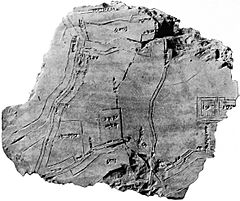Hilprecht Collection
The Hilprecht Collection of Near Eastern Antiquities is a collection of archaeological finds from the Near East at the Institute for Languages and Cultures of the Near East of the Friedrich Schiller University Jena . Today it comprises around 3300 exhibits, including around 3000 cuneiform texts from almost all eras and text genres from a period of almost 3000 years.
The collection comes mainly from the estate of the German-American professor of Assyriology and archeology Hermann Volrath Hilprecht . The best-known exhibit is the city map of Nippur from the middle of the 2nd century. v. BC, which is the oldest surviving city map to date. After the Vorderasiatisches Museum in Berlin, the Hilprecht collection is the most extensive collection of its kind in Germany.
history
Most of the exhibits come from Hilprecht's excavation trips. Hilprecht, who was then a professor of Assyriology in Philadelphia , took part in the first excavations in 1889 in Nippur, one of the most important cities of ancient Mesopotamia (now Iraq ). In the following years he was a member of the Scientific Committee in Philadelphia and participated in two other excavations in Nippur and Constantinople . From 1898 to 1900 he was head of the fourth excavation expedition to Nippur.
After Hilprecht's death in 1925, in accordance with his last will, the collection was bequeathed to the Friedrich Schiller University in Jena and named "Frau Professor Hilprecht Collection of Babylonian Antiquities" in memory of his first wife . Later the name was changed to “Frau Professor Hilprecht Collection of Babylonian Antiquities” and “Hilprecht Collection of Near Eastern Antiquities” .
In 1932/33 the collection was expanded to include Hilprecht's written estate from his sister's possession. Enclosed are also his scrolls of ancient oriental seals and Islamic faience tiles.
More pieces were added to the Hilprecht collection. The botanist Heinrich Carl Haussknecht added exhibits that he had acquired on his travels. The orientalist Arthur Ungnad also added other pieces.
Digitization with imaging processes

Already in the years 1999-2000 some of the exhibits - the oldest from the 4th-3rd Millennium BC d. Z. - the Hilprecht collection captured with a flatbed scanner . These are publicly accessible on the Cuneiform Digital Library Initiative (CDLI) portal . The University of California (Los Angeles), the University of Oxford and the Max Planck Institute for the History of Science were involved in this first digitization .
In a second project, a 3D scanner was used from 2009 to take account of technical developments. The driving forces here were Manfred Krebernik, who holds the chair for Ancient Near Eastern Studies at the FSU-Jena , and also oversees the collection, and Peter Damerow from the MPI for the History of Science. The MPI has made a high-resolution 3D scanner available for this. This means that around 3000 objects in the collection are documented in three dimensions. Currently (as of June 2018) around 2500 objects have already been recorded as a 3D model. Almost 2000 of these can be accessed via the Hilprecht Archive Online under the CC BY license (as of March 2019). After the project is complete, the collection will be made available to the public.
The 3D models available in 1977 were cleaned, oriented, filtered and given a very high-contrast texture using the GigaMesh software framework . Standardized high-resolution page views of this were rendered as PNG and merged as fat cross in a PDF . There is also calculated metadata such as dimensions, area or volume. Entries in the CDLI could be found automatically for 707 data records and added as metadata. All revised tables and their views are available as a benchmark database (HeiCuBeDa) and as an image database including metadata-containing 3D data (HeiCu3Da).
Web links
- History of the collection
- Information on Jena Ancient Near Eastern Studies and the Hilprecht Collection
- The Hilprecht collection on the website of the FSU-Jena overview page
credentials
- ↑ Laser beam meets ancient clay tablets, p. 26, in: Lichtgedanken - The magazine of the Friedrich-Schiller-Universität-Jena 04/2018
- ↑ Hilprecht collection in the CDLI. Retrieved March 29, 2019 .
- ↑ Hilprecht Archive Online (HAO) with the 3D exhibits. Retrieved March 29, 2019 .
- ↑ Laser beam meets ancient clay tablets, p. 26f, in: Lichtgedanken - The magazine of the Friedrich-Schiller-Universität-Jena 04/2018
- ↑ Hubert Mara: HeiCuBeDa Hilprecht - Heidelberg Cuneiform Benchmark Dataset for the Hilprecht Collection . heiDATA - institutional repository for research data of Heidelberg University, June 7, 2019, doi : 10.11588 / data / IE8CCN .
- ↑ Hubert Mara: HeiCu3Da Hilprecht - Heidelberg Cuneiform 3D Database - Hilprecht Collection . heidICON - The Heidelberg property and multimedia database, June 7th, 2019, doi : 10.11588 / heidicon.hilprecht .
- ↑ Hubert Mara and Bartosz Bogacz: Breaking the Code on Broken Tablets: The Learning Challenge for Annotated Cuneiform Script in Normalized 2D and 3D Datasets . In: Proceedings of the 15th International Conference on Document Analysis and Recognition ( ICDAR ) . Sidney, Australia 2019, doi : 10.1109 / ICDAR.2019.00032 .
Coordinates: 50 ° 55 ′ 46.8 " N , 11 ° 35 ′ 22.1" E

